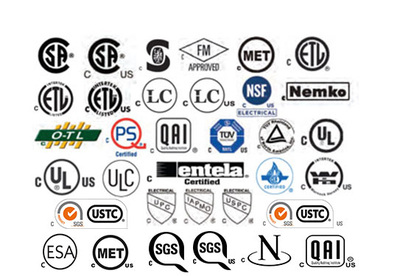Electrical Certification for use in Canada: Recognizing Certification and Why It's Important9/22/2014
Electrical certification is a must for any electrical tools bought, sold, or used in Canada. Tools must be tested by an accredited certification organization to determine that they meet the applicable safety standards and adhere to the Canadian Electrical Code. The Standards Council of Canada handles the accreditation of inspection bodies and together with provincial Safety Authorities oversees enforcement.
Recognizing Certified vs. Non-Certified Tools
There are two types of acceptable certification indicators: marks and labels. A mark will be printed directly onto the housing of the tool. A label will be a sticker added to the tool housing after production by a field inspector. The mark or label must be on the tool itself; it is not valid if it appears only on the box or marketing material for a tool. In some cases, particularly on tools that are handled regularly, the certification label can wear off. We keep a record of tools and their certification numbers sold to our customers but we recommend you record these numbers someplace safe in case of inspection by your local Safety Authority. A common mark found on tools manufactured or sold in Europe is CE. The CE marking does not constitute certification for use in Canada. It is self-declared by manufacturers, not verified by third-parties, and declares conformity to European directives which are different from Canadian requirements. See the Standards Council of Canada website for an up-to-date listing of accredited inspection bodies and their individual marks to confirm your tools are properly certified for use in Canada.
Examples of certification marks and field inspection labels that are acceptable in Ontario. Please visit the Electrical Safety Authority for an accurate list of acceptable marks for Ontario.
Why is Certification Important?
Certification is important not just because it is the law but because of the possible safety and legal ramifications that can occur from using uncertified tools. In order to receive a certification mark or label, a tool must be deemed safe to operate. Tests are performed by an inspection body to ensure the tool is not a shock hazard, is made of appropriate materials, and does not pose a risk of fire, among other things. In Ontario, a conviction for failing to comply with the OESC can result in a person being fined up to $50,000 and/or imprisonment of not more than one year; a corporation can be fined up to $1,000,000. ESA also has the authority to order products be quarantined, seized or forfeited to the Crown for disposal. [Source: Electrical Safety Authority.] The information in this article is meant only as an overview of this topic. Please contact the Standards Council of Canada or your local Safety Authority for up-to-date information. Comments are closed.
|
|
STANMECH Technologies Inc.
944 Zelco Drive Burlington ON L7L 4Y3 | 1-888-438-6324 | [email protected] Terms of Use Privacy Terms and Conditions of Sale Warranty Policies |
|
Proud Member of:



